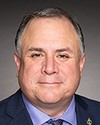Madam Speaker, I am pleased to rise today as the Bloc Québécois critic on indigenous affairs to shed some light on the bill currently before us, namely Bill C‑23, an act respecting places, persons and events of national historic significance or national interest, archaeological resources and cultural and natural heritage.
I will not talk about everything in the bill. It is an update and a reworking of an act from 1985. As the indigenous affairs critic, I would like to draw specific attention to its reference to indigenous peoples. It is in the bill's preamble, in fact. It is one of the biggest changes to the Historic Sites and Monuments Act.
Madam Speaker, I apologize. I forgot to indicate that I will be sharing my time with my invaluable colleague, as my leader would say, the member for Terrebonne. Now back to my speech.
As I was saying, one of the major changes in the bill is the voice given to indigenous peoples. There is a reference to the Truth and Reconciliation Commission, or TRC, in the bill's preamble.
More specifically, the bill refers to call to action 79, which is quite long. To paraphrase, the idea is to work more and more with first nations so that they feel like they are active participants in everything that has to do with heritage. We are talking about parks and all the historic sites of commemoration or national interest.
There is also a reference to the UN Declaration on the Rights of Indigenous Peoples. The preamble is meant to respond to articles 15.1 and 15.2 of the declaration, which should, in theory, be implemented in the next few months. I know that the consultation process is over. This is a first step.
There are structural changes in the bill, for example, on the issue of powers and on the legislative framework for offences. I would like to focus on the issue of structure for the sake of consistency and out of respect. This still relates to what I just mentioned, specifically, the TRC's call to action 79 and articles 15.1 and 15.2 of the UN Declaration on the Rights of Indigenous Peoples.
That said, the Bloc Québécois is in favour of the bill. The perfect is the enemy of the good, but we can improve it. In any event, that is the purpose of second reading and referring the bill to committee, where changes can be made. Even though we are in favour of the bill, I would like to raise a few points about its structure.
I want to clarify that I will be talking about two major changes. One of them is representation. Previously, the act did not give first nations representatives a seat at the table. Three positions are now being added to the Historic Sites and Monuments Board of Canada. Three new members will sit on the board. That is the first thing. It is in subclause 9(2) of the bill, which reads as follows:
Representatives for First Nations, Inuit and Métis
(2) The representatives appointed under paragraph 8(2)(b) are to be appointed on the recommendation of the Minister made after the Minister has consulted with a variety of Indigenous governing bodies and a variety of entities that represent the interests of Indigenous groups and their members.
That is the first thing. We are seeing some progress. I will come back to it later to suggest improvements that could be made with respect to representation.
Then there is also the issue of tenure of office. The relevant clause reads as follows:
10 (1) A member appointed by the Governor in Council holds office during pleasure for a term fixed by the Governor and Council of up to five years, but they continue to hold office until their successor is appointed.
Reappointment
(2) A member may be reappointed.
As I interpret it, a reappointed member would have no time limit or term limit.
Clearly, the fact that the board will have first nations, Métis and Inuit representatives is in itself an important change. Of course there are places of interest to them that they wish to preserve and that are meaningful for them and the population at large. We must also identify these places, learn about them and recognize their existence and importance.
That said, I worked on Bill C‑29, which provides for the establishment of a council whose purpose is to monitor the progress of reconciliation efforts. I thought that Bill C‑29 went much further than Bill C-23. Obviously, Bill C‑29 also stated that indigenous representatives needed a seat at the table, but first nations, Métis and Inuit communities were guaranteed a seat too. This bill mentions first nations, Métis and Inuit representatives, but the wording of subclause 9(2) does not guarantee that the Inuit, Métis and first nations will be represented. It is a possibility, but there is no indication that everyone will be at the table. That is something I wanted to raise.
There is also the issue of the process. Will all due respect, I find that the process is unclear. Of course, the Governor in Council will be able to take part in the recommendation, but we still do not know which indigenous governing bodies will be consulted. Once again, does this mean that the Métis, Inuit and first nations peoples will all be consulted, or just a few groups chosen at random? The same applies to the question of indigenous interest groups. We have no idea how inclusive this will be. The preamble says that one of the aims of the bill is inclusivity. Yes, there is some opportunity for inclusivity, but there is no guarantee that each of the various indigenous interest groups or governing bodies will be represented.
Then, there is the tenure of office. Individuals will be appointed rather than elected. In my view, the fact that there may be changes and that the deck may be shuffled at some point is a good thing, it could create new energy and at least give the impression of greater representativeness. In this respect, I would like to make a comparison with the clauses of the current version of Bill C-29 regarding nominations. It is not exactly the same thing, but there is a guarantee that a member of the board may be elected only after being nominated by the Assembly of First Nations, by Inuit Tapiriit Kanatami, therefore the Inuit, by the Métis National Council, and by the Native Women’s Association of Canada.
In Bill C-29, there is an attempt at representativeness, and there is also a guarantee that specific groups will be consulted. Nothing is left to chance. I am not saying that it is perfect, because it is not up to me to say whether indigenous groups feel represented or not. It is up to them to decide. However, here we are at least trying to cast the widest net possible, and we are offering guarantees to all three groups. That is something.
The same applies to the term of office. Bill C-29 allows for a maximum of two terms. After that, there will be changes to the board. I feel that Bill C-23 might be stronger if it was modeled on Bill C-29. This is only a small part of the bill, but I wanted to mention it because of the whole issue of consultation, which is crucial for the first nations. Out of respect for the first nations, and for the sake of inclusivity and transparency, I think that, when it comes to Bill C-23, we would be wise to look at the work done on Bill C-29 to ensure a fair and diverse representation of all three groups of indigenous peoples.








